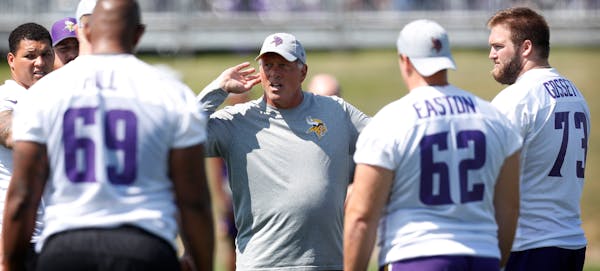The deck outside the second floor of the Vikings' sprawling new team headquarters in Eagan has become something of a retreat for the team's front office. It's where Vikings executives can step outside on a summer night, with a beverage in hand from a nearby refrigerator, watch the sunset over the trees to the west of the practice fields and unwind after a long day.
Recently, it's also doubled as something of a command center for perhaps the NFL's most ambitious roster-building effort.
The five-year, $72 million deal wide receiver Stefon Diggs signed on Tuesday will go into effect next year, making him the ninth player on the 2019 Vikings with a contract that carries a yearly average over $10 million in each of its first three seasons.
Though things can change quickly in the NFL, no other team in the league is currently scheduled to have more than eight such contracts in 2019.
Of the Vikings' nine big contracts, eight have been signed since March 2017. Six of them — the deals given to Everson Griffen, Linval Joseph, Xavier Rhodes, Eric Kendricks, Danielle Hunter and now Diggs — have been part of the team's bold plan to secure a raft of core players scheduled to hit free agency after the 2018 season.
"I think [Vice President of Football Operations] Rob [Brzezinski] does an unbelievable job in the way he structures these contracts," General Manager Rick Spielman said. "I think it rewards the player, but it's also ideal on how we want our contracts structured. Any time you go into a negotiation, to me, it's not, 'Well, we beat you, or you beat us.' You go in with an attitude of, 'Listen, your guy deserves the money he's going to get, but we need some things, too.' I mean, we don't want to lose these players, but we have some parameters we need to work in."
After Diggs' deal, the question will inevitably shift to whether the Vikings can do one more deal before next March, and if they put Brzezinski's nimble salary cap management skills to work, it's likely they can.
The question could hinge more on which player on their roster they believe is worth paying.
We'll deal first with the financial picture: Diggs' deal, which includes a $15 million signing bonus, should tack an additional $3 million of cap charges onto the Vikings' 2018 books. That leaves the Vikings with $9.88 million in remaining cap space in 2018, with the ability to roll over anything they don't use into next season. Conservatively, we'll set aside another $2 million for expenses in 2018, and give them $7.88 million of rollover space, adding that to overthecap.com's assumption of a $190 million cap in 2019.
Assuming a cap charge in the neighborhood of $13 million for Diggs next season, and adding the Vikings' $7.88 million of rollover space, they'd still have roughly $12.6 million of cap space left for 2019. Safety Andrew Sendejo has a $5.5 million option for 2019; if the Vikings decline to pick it up, they'd have $18.1 million of available space (not including any incentives that could adjust the cap at the end of the season).
At the moment, the Vikings would sit roughly $24 million under a 2020 cap of $200 million, before any moves with veterans that could clear additional space in the coming years. Doing another long-term deal could be a tricky task, to be sure, but the Vikings' typical cap ingenuity means it's not impossible — if the Vikings believe there's a player who's worth it.
Is that player linebacker Anthony Barr? The ninth pick in 2014 is playing on a guaranteed fifth-year option of $12.3 million this season, as he works with defensive line coach Andre Patterson in an effort to improve his pass rushing productivity. Until the Vikings know whether Barr can become the type of force they envisioned he'd be when they drafted him, they might wait to pay him — and if he responds with a big year that includes eight or 10 sacks, he might pique the interest of a team that wants to make him a full-time pass rusher in their 3-4 defense.
That brings us to Pro Bowler Sheldon Richardson, who plays what might be the most important position in Mike Zimmer's defense, three-technique defensive tackle. The Vikings signed Richardson to a one-year, $8 million deal in March, betting the 2013 Defensive Rookie of the Year would excel in their defense and stay clear of off-field issues. The 27-year-old has played to rave reviews in training camp, and a year after knee injuries curtailed the career of first-round pick Sharrif Floyd, the Vikings could lock up a critical piece on their decorated line by paying Richardson.
The questions never end: Adam Thielen, who gained more yards than Diggs in 2016 and made the Pro Bowl last year, could push after this season to rework a deal that runs through 2020 but is drastically below market value. Cornerback Trae Waynes, the 11th pick in 2015, will become a free agent after 2020. In the end, the Vikings have to be as good scouting their own players as they are at paying them.
Spielman on Tuesday recalled the first deal the Vikings gave Griffen, for five years and $42.5 million in 2014. He'd spent four years behind Jared Allen; the Vikings paid market rate for him because they believed in what he'd become.
Four years, three Pro Bowls and a second contract later, the Vikings have been proved right on Griffen. Their instincts, as much as their pocketbook, could determine what they do next.
"Hopefully we're really honed in on those types of guys, that we really believe in, not only as football people, but as men, as well," Spielman said.
Ben Goessling covers the Vikings for the Star Tribune.
